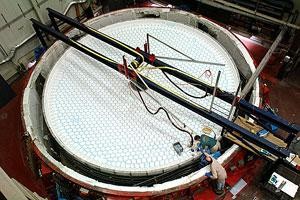The UA’s Steward Observatory Mirror Laboratory is hard at work with its share of the construction on the Large Synoptic Survey Telescope, which has been under development since 2000 and still faces another six years of development.
Once completed, the complex, high-powered telescope – whose parts are being built all over the world – will sit atop Cerro Pachon, a mountain in northern Chile, and provide digital time-lapse imaging of items across the entire sky.
The shutters on the telescope’s camera open for 15 seconds and catalog areas seven times larger than the diameter of the moon in one image.
“”The telescope is unique not because it has the biggest aperture, but because it moves so fast,”” said LSST project manager Donald Sweeney. “”It is hundreds of times faster than other telescopes.””
The images will capture thousands of known phenomena, such as stars and exploding supernova, each night. But the telescope’s main purpose is to help scientists and astronomers understand dark matter, which makes up the mass in the sky astronomers cannot account for.
“”The LSST will build a database to service many scientific endeavors,”” said Victor Krabbendam, LSST telescope and site project manager.
Upon completion, the ground-based device will be approximately 27 feet in diameter. It will consist of three mirrors that will capture the light and send it to the telescope’s camera.
The lab is constructing the primary and tertiary mirrors, which will be combined to make one piece.
They have been under production for about a year and a half and should be completed in the spring, Krabbendam said.
When the mirrors are completed, they will be driven by truck to the telescope’s location in Chile, Sweeney said.
Recently, the project received a large sum of money from Microsoft founder Bill Gates and computer software executive Charles Simonyi, who have donated $30 million to help fund the production of the telescope’s three mirrors, as well as other projects.
“”The two men have a genuine enthusiasm for novel projects and imaginative use of technology,”” Krabbendam said.
Construction is being overseen by the LSST Corporation, a non-profit organization of more than 100 members, including scientists and astronomers, in Tucson. It is also a partnership of more than 23 other organizations aiding to build the telescope.
Its founding organizations are the UA, the University of Washington, the National Optical Astronomy Observatory and the Research Corporation. Partner organizations include Princeton, Harvard, Purdue, the California Institute of Technology, Columbia University and Google.









